Analysis of Merit, Quotas, and Targets in Political Contexts
VerifiedAdded on 2022/11/29
|9
|2220
|187
Essay
AI Summary
This essay provides a critical analysis of the debates surrounding merit, quotas, and targets in the context of political representation, with a particular focus on gender equality. It examines the merit system, highlighting its limitations in promoting gender equality and its potential biases. The essay then delves into gender quotas, exploring their effectiveness in enhancing female political engagement and representation, while also acknowledging criticisms and suggesting comprehensive approaches. It also discusses voluntary target systems adopted by political parties. The essay further identifies factors that relate to the implemented change, including political culture, education, and leadership training. The essay concludes by emphasizing the importance of gender quotas in promoting gender equality in the political field, while also acknowledging the need for context-specific implementation and the importance of addressing underlying cultural and systemic biases. The essay also provides a detailed overview of the benefits and drawbacks of each system, with a focus on how issues might change over time, in different cultural or industry contexts.

NEGOTIATION, MEDIATION AND COMMUNITY CONSULTATION 1
Negotiation, Mediation, and Community Consultation
Student’s Name
Professor’s Name
Course
Institution of Affiliation
Date
Negotiation, Mediation, and Community Consultation
Student’s Name
Professor’s Name
Course
Institution of Affiliation
Date
Paraphrase This Document
Need a fresh take? Get an instant paraphrase of this document with our AI Paraphraser

NEGOTIATION, MEDIATION AND COMMUNITY CONSULTATION 2
Negotiation, Mediation, and Community Consultation
In the past century, women recognition as viable and valuable political forces have
been gathering momentums after being catalysed by the different movements of social rights
as well as equality movements. The movement focuses on the promotion of gender equality
as well as the empowerment of women (Pande and Ford 2012). Nonetheless, the progress on
this matter has been slow since nations are yet to reach gender parity in all levels of
education. The idea of gender equality is developed at the distinctive educational level,
which is tailored to equip women with leadership as well as civic skills necessary to make a
contribution that is informed to policy debates (Kleemann, Nunnenkamp, and Thiele 2016).
The essay expounds on the effectiveness of the recent gender quotas as a phenomenon as a
tool for enhancing female political representation as well as meaningful engagement as
compared to the concept of merit and targets while identifying all the factors that relate to the
implemented change.
Merit System
The merit system is a process through which government employees are hired or
promoted based on their ability to perform a given job and not based on the gender quotas
and target system. However, it is imperative to note that the merit system has been deemed
to fail to enhance gender equality. The only importance of the merit system in terms of
selection is to make sure that there is a good quality of work that is provided to the members
of the public (Escandón 2018). It is imperative to note that the use of merit in the process of
selection, hiring, or promotion an honest effective, as well as productive decision-making the
legislative team, is created.
The primary principle of the merit system is motivation as well as the trust of the
elected members of parliament. Members of parliament that are selected based on the merit
Negotiation, Mediation, and Community Consultation
In the past century, women recognition as viable and valuable political forces have
been gathering momentums after being catalysed by the different movements of social rights
as well as equality movements. The movement focuses on the promotion of gender equality
as well as the empowerment of women (Pande and Ford 2012). Nonetheless, the progress on
this matter has been slow since nations are yet to reach gender parity in all levels of
education. The idea of gender equality is developed at the distinctive educational level,
which is tailored to equip women with leadership as well as civic skills necessary to make a
contribution that is informed to policy debates (Kleemann, Nunnenkamp, and Thiele 2016).
The essay expounds on the effectiveness of the recent gender quotas as a phenomenon as a
tool for enhancing female political representation as well as meaningful engagement as
compared to the concept of merit and targets while identifying all the factors that relate to the
implemented change.
Merit System
The merit system is a process through which government employees are hired or
promoted based on their ability to perform a given job and not based on the gender quotas
and target system. However, it is imperative to note that the merit system has been deemed
to fail to enhance gender equality. The only importance of the merit system in terms of
selection is to make sure that there is a good quality of work that is provided to the members
of the public (Escandón 2018). It is imperative to note that the use of merit in the process of
selection, hiring, or promotion an honest effective, as well as productive decision-making the
legislative team, is created.
The primary principle of the merit system is motivation as well as the trust of the
elected members of parliament. Members of parliament that are selected based on the merit
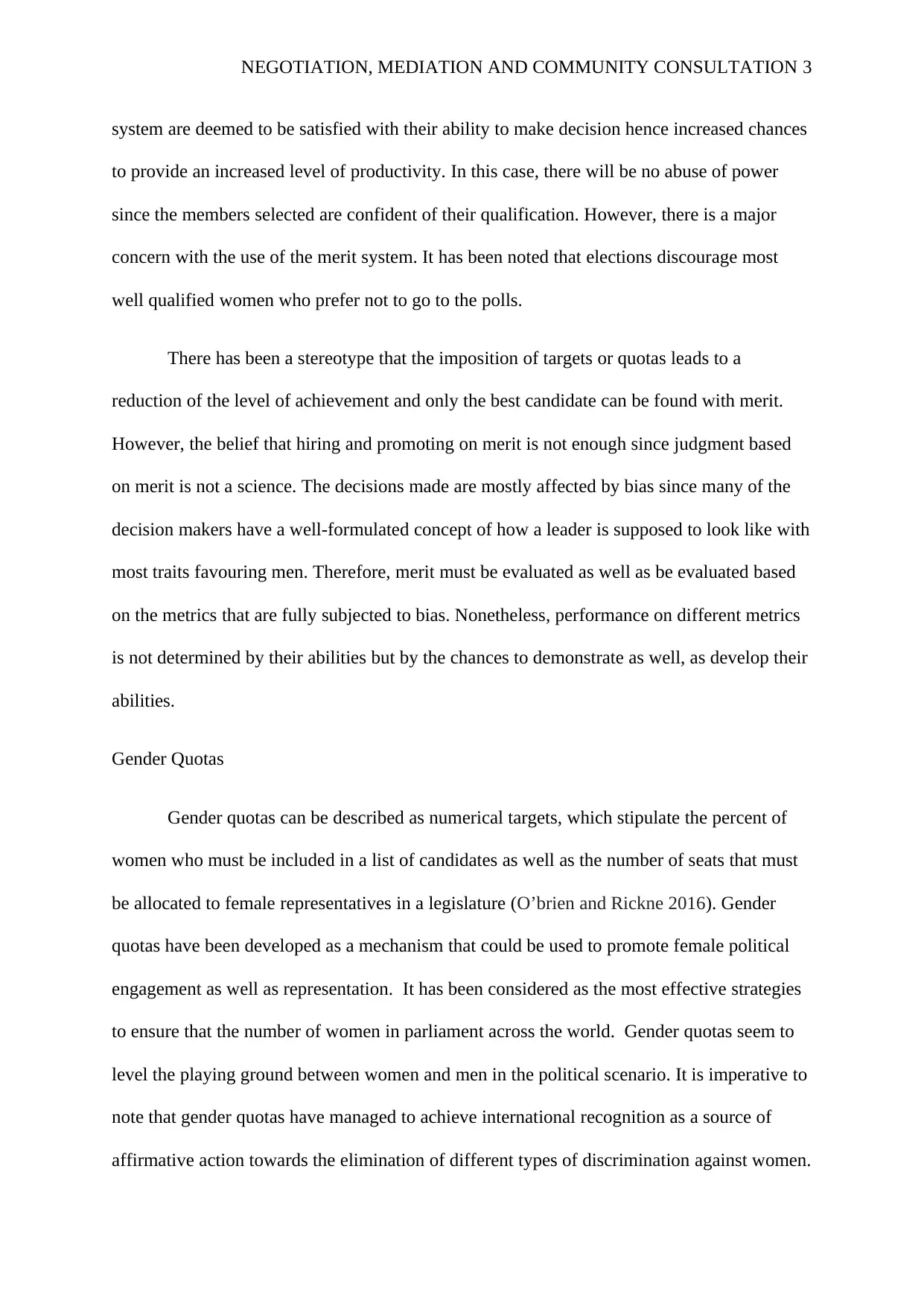
NEGOTIATION, MEDIATION AND COMMUNITY CONSULTATION 3
system are deemed to be satisfied with their ability to make decision hence increased chances
to provide an increased level of productivity. In this case, there will be no abuse of power
since the members selected are confident of their qualification. However, there is a major
concern with the use of the merit system. It has been noted that elections discourage most
well qualified women who prefer not to go to the polls.
There has been a stereotype that the imposition of targets or quotas leads to a
reduction of the level of achievement and only the best candidate can be found with merit.
However, the belief that hiring and promoting on merit is not enough since judgment based
on merit is not a science. The decisions made are mostly affected by bias since many of the
decision makers have a well-formulated concept of how a leader is supposed to look like with
most traits favouring men. Therefore, merit must be evaluated as well as be evaluated based
on the metrics that are fully subjected to bias. Nonetheless, performance on different metrics
is not determined by their abilities but by the chances to demonstrate as well, as develop their
abilities.
Gender Quotas
Gender quotas can be described as numerical targets, which stipulate the percent of
women who must be included in a list of candidates as well as the number of seats that must
be allocated to female representatives in a legislature (O’brien and Rickne 2016). Gender
quotas have been developed as a mechanism that could be used to promote female political
engagement as well as representation. It has been considered as the most effective strategies
to ensure that the number of women in parliament across the world. Gender quotas seem to
level the playing ground between women and men in the political scenario. It is imperative to
note that gender quotas have managed to achieve international recognition as a source of
affirmative action towards the elimination of different types of discrimination against women.
system are deemed to be satisfied with their ability to make decision hence increased chances
to provide an increased level of productivity. In this case, there will be no abuse of power
since the members selected are confident of their qualification. However, there is a major
concern with the use of the merit system. It has been noted that elections discourage most
well qualified women who prefer not to go to the polls.
There has been a stereotype that the imposition of targets or quotas leads to a
reduction of the level of achievement and only the best candidate can be found with merit.
However, the belief that hiring and promoting on merit is not enough since judgment based
on merit is not a science. The decisions made are mostly affected by bias since many of the
decision makers have a well-formulated concept of how a leader is supposed to look like with
most traits favouring men. Therefore, merit must be evaluated as well as be evaluated based
on the metrics that are fully subjected to bias. Nonetheless, performance on different metrics
is not determined by their abilities but by the chances to demonstrate as well, as develop their
abilities.
Gender Quotas
Gender quotas can be described as numerical targets, which stipulate the percent of
women who must be included in a list of candidates as well as the number of seats that must
be allocated to female representatives in a legislature (O’brien and Rickne 2016). Gender
quotas have been developed as a mechanism that could be used to promote female political
engagement as well as representation. It has been considered as the most effective strategies
to ensure that the number of women in parliament across the world. Gender quotas seem to
level the playing ground between women and men in the political scenario. It is imperative to
note that gender quotas have managed to achieve international recognition as a source of
affirmative action towards the elimination of different types of discrimination against women.
⊘ This is a preview!⊘
Do you want full access?
Subscribe today to unlock all pages.

Trusted by 1+ million students worldwide
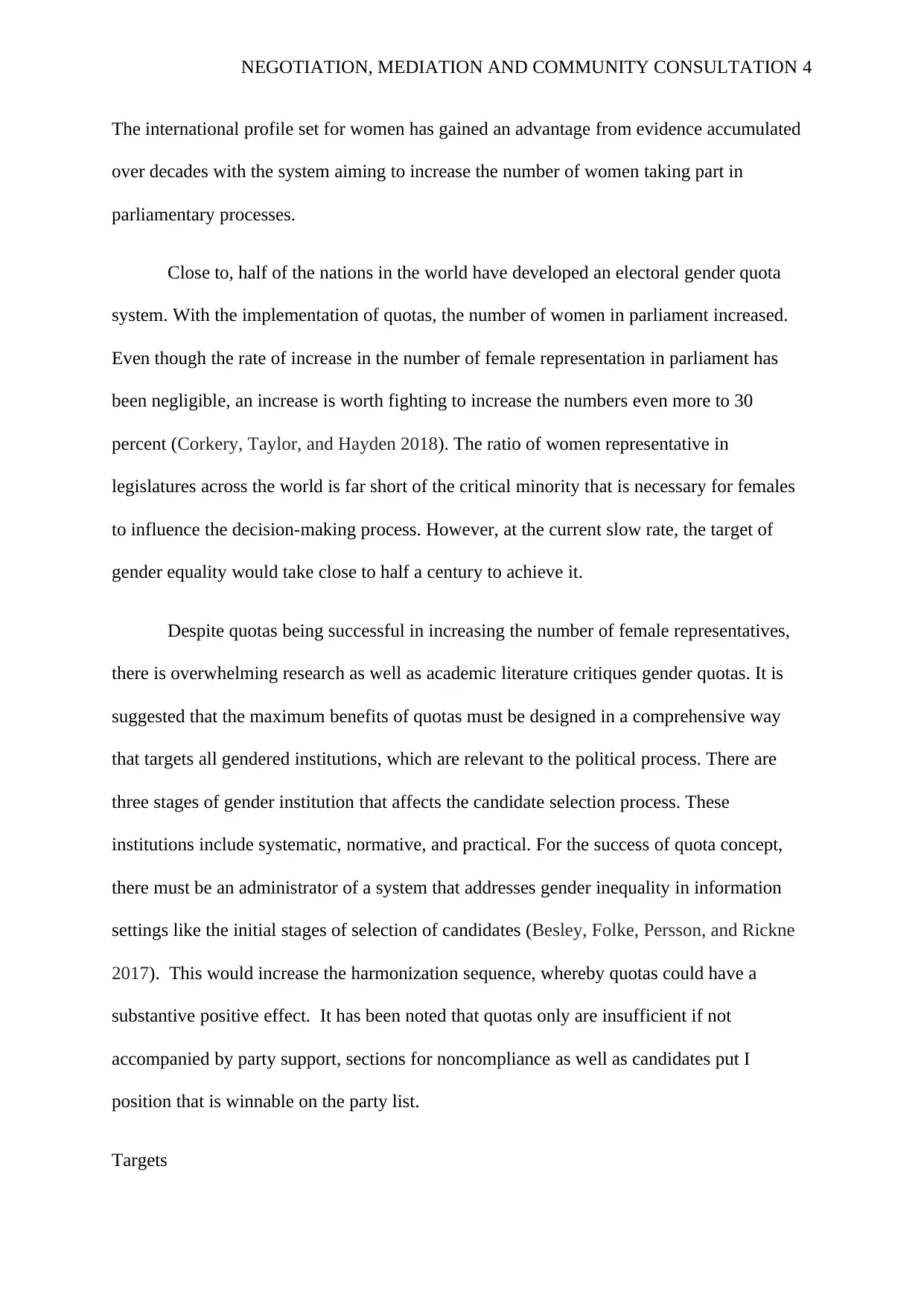
NEGOTIATION, MEDIATION AND COMMUNITY CONSULTATION 4
The international profile set for women has gained an advantage from evidence accumulated
over decades with the system aiming to increase the number of women taking part in
parliamentary processes.
Close to, half of the nations in the world have developed an electoral gender quota
system. With the implementation of quotas, the number of women in parliament increased.
Even though the rate of increase in the number of female representation in parliament has
been negligible, an increase is worth fighting to increase the numbers even more to 30
percent (Corkery, Taylor, and Hayden 2018). The ratio of women representative in
legislatures across the world is far short of the critical minority that is necessary for females
to influence the decision-making process. However, at the current slow rate, the target of
gender equality would take close to half a century to achieve it.
Despite quotas being successful in increasing the number of female representatives,
there is overwhelming research as well as academic literature critiques gender quotas. It is
suggested that the maximum benefits of quotas must be designed in a comprehensive way
that targets all gendered institutions, which are relevant to the political process. There are
three stages of gender institution that affects the candidate selection process. These
institutions include systematic, normative, and practical. For the success of quota concept,
there must be an administrator of a system that addresses gender inequality in information
settings like the initial stages of selection of candidates (Besley, Folke, Persson, and Rickne
2017). This would increase the harmonization sequence, whereby quotas could have a
substantive positive effect. It has been noted that quotas only are insufficient if not
accompanied by party support, sections for noncompliance as well as candidates put I
position that is winnable on the party list.
Targets
The international profile set for women has gained an advantage from evidence accumulated
over decades with the system aiming to increase the number of women taking part in
parliamentary processes.
Close to, half of the nations in the world have developed an electoral gender quota
system. With the implementation of quotas, the number of women in parliament increased.
Even though the rate of increase in the number of female representation in parliament has
been negligible, an increase is worth fighting to increase the numbers even more to 30
percent (Corkery, Taylor, and Hayden 2018). The ratio of women representative in
legislatures across the world is far short of the critical minority that is necessary for females
to influence the decision-making process. However, at the current slow rate, the target of
gender equality would take close to half a century to achieve it.
Despite quotas being successful in increasing the number of female representatives,
there is overwhelming research as well as academic literature critiques gender quotas. It is
suggested that the maximum benefits of quotas must be designed in a comprehensive way
that targets all gendered institutions, which are relevant to the political process. There are
three stages of gender institution that affects the candidate selection process. These
institutions include systematic, normative, and practical. For the success of quota concept,
there must be an administrator of a system that addresses gender inequality in information
settings like the initial stages of selection of candidates (Besley, Folke, Persson, and Rickne
2017). This would increase the harmonization sequence, whereby quotas could have a
substantive positive effect. It has been noted that quotas only are insufficient if not
accompanied by party support, sections for noncompliance as well as candidates put I
position that is winnable on the party list.
Targets
Paraphrase This Document
Need a fresh take? Get an instant paraphrase of this document with our AI Paraphraser
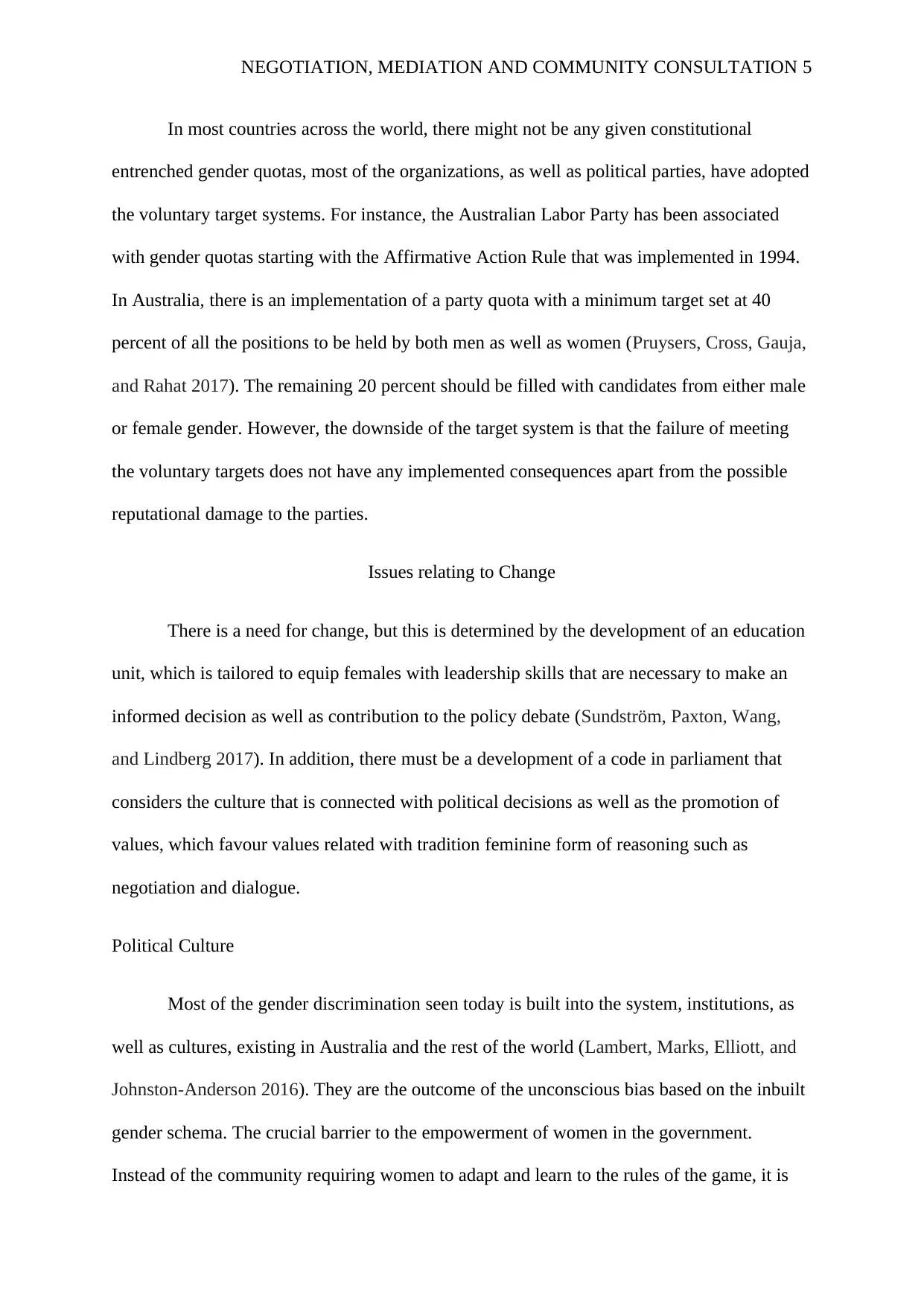
NEGOTIATION, MEDIATION AND COMMUNITY CONSULTATION 5
In most countries across the world, there might not be any given constitutional
entrenched gender quotas, most of the organizations, as well as political parties, have adopted
the voluntary target systems. For instance, the Australian Labor Party has been associated
with gender quotas starting with the Affirmative Action Rule that was implemented in 1994.
In Australia, there is an implementation of a party quota with a minimum target set at 40
percent of all the positions to be held by both men as well as women (Pruysers, Cross, Gauja,
and Rahat 2017). The remaining 20 percent should be filled with candidates from either male
or female gender. However, the downside of the target system is that the failure of meeting
the voluntary targets does not have any implemented consequences apart from the possible
reputational damage to the parties.
Issues relating to Change
There is a need for change, but this is determined by the development of an education
unit, which is tailored to equip females with leadership skills that are necessary to make an
informed decision as well as contribution to the policy debate (Sundström, Paxton, Wang,
and Lindberg 2017). In addition, there must be a development of a code in parliament that
considers the culture that is connected with political decisions as well as the promotion of
values, which favour values related with tradition feminine form of reasoning such as
negotiation and dialogue.
Political Culture
Most of the gender discrimination seen today is built into the system, institutions, as
well as cultures, existing in Australia and the rest of the world (Lambert, Marks, Elliott, and
Johnston-Anderson 2016). They are the outcome of the unconscious bias based on the inbuilt
gender schema. The crucial barrier to the empowerment of women in the government.
Instead of the community requiring women to adapt and learn to the rules of the game, it is
In most countries across the world, there might not be any given constitutional
entrenched gender quotas, most of the organizations, as well as political parties, have adopted
the voluntary target systems. For instance, the Australian Labor Party has been associated
with gender quotas starting with the Affirmative Action Rule that was implemented in 1994.
In Australia, there is an implementation of a party quota with a minimum target set at 40
percent of all the positions to be held by both men as well as women (Pruysers, Cross, Gauja,
and Rahat 2017). The remaining 20 percent should be filled with candidates from either male
or female gender. However, the downside of the target system is that the failure of meeting
the voluntary targets does not have any implemented consequences apart from the possible
reputational damage to the parties.
Issues relating to Change
There is a need for change, but this is determined by the development of an education
unit, which is tailored to equip females with leadership skills that are necessary to make an
informed decision as well as contribution to the policy debate (Sundström, Paxton, Wang,
and Lindberg 2017). In addition, there must be a development of a code in parliament that
considers the culture that is connected with political decisions as well as the promotion of
values, which favour values related with tradition feminine form of reasoning such as
negotiation and dialogue.
Political Culture
Most of the gender discrimination seen today is built into the system, institutions, as
well as cultures, existing in Australia and the rest of the world (Lambert, Marks, Elliott, and
Johnston-Anderson 2016). They are the outcome of the unconscious bias based on the inbuilt
gender schema. The crucial barrier to the empowerment of women in the government.
Instead of the community requiring women to adapt and learn to the rules of the game, it is
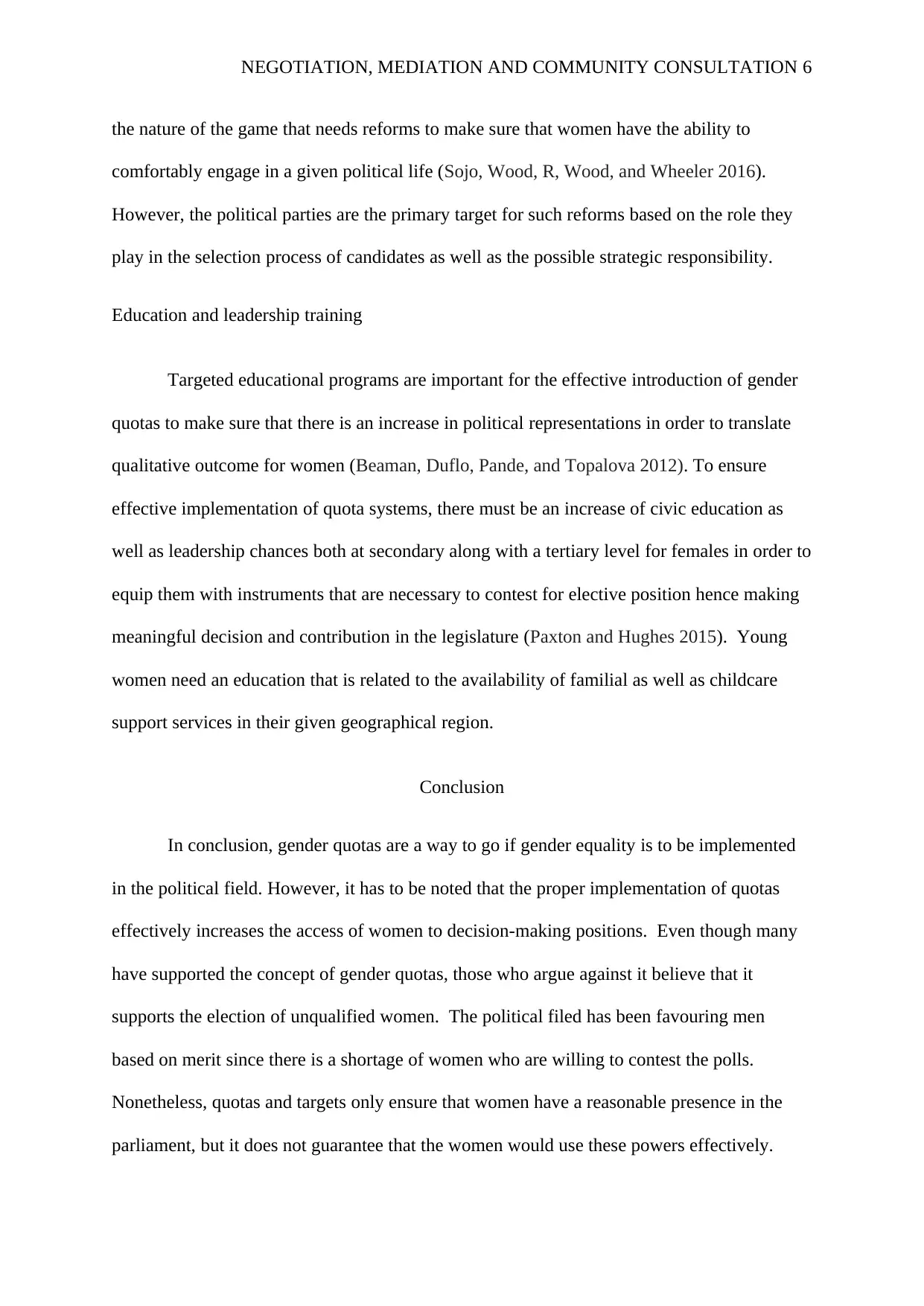
NEGOTIATION, MEDIATION AND COMMUNITY CONSULTATION 6
the nature of the game that needs reforms to make sure that women have the ability to
comfortably engage in a given political life (Sojo, Wood, R, Wood, and Wheeler 2016).
However, the political parties are the primary target for such reforms based on the role they
play in the selection process of candidates as well as the possible strategic responsibility.
Education and leadership training
Targeted educational programs are important for the effective introduction of gender
quotas to make sure that there is an increase in political representations in order to translate
qualitative outcome for women (Beaman, Duflo, Pande, and Topalova 2012). To ensure
effective implementation of quota systems, there must be an increase of civic education as
well as leadership chances both at secondary along with a tertiary level for females in order to
equip them with instruments that are necessary to contest for elective position hence making
meaningful decision and contribution in the legislature (Paxton and Hughes 2015). Young
women need an education that is related to the availability of familial as well as childcare
support services in their given geographical region.
Conclusion
In conclusion, gender quotas are a way to go if gender equality is to be implemented
in the political field. However, it has to be noted that the proper implementation of quotas
effectively increases the access of women to decision-making positions. Even though many
have supported the concept of gender quotas, those who argue against it believe that it
supports the election of unqualified women. The political filed has been favouring men
based on merit since there is a shortage of women who are willing to contest the polls.
Nonetheless, quotas and targets only ensure that women have a reasonable presence in the
parliament, but it does not guarantee that the women would use these powers effectively.
the nature of the game that needs reforms to make sure that women have the ability to
comfortably engage in a given political life (Sojo, Wood, R, Wood, and Wheeler 2016).
However, the political parties are the primary target for such reforms based on the role they
play in the selection process of candidates as well as the possible strategic responsibility.
Education and leadership training
Targeted educational programs are important for the effective introduction of gender
quotas to make sure that there is an increase in political representations in order to translate
qualitative outcome for women (Beaman, Duflo, Pande, and Topalova 2012). To ensure
effective implementation of quota systems, there must be an increase of civic education as
well as leadership chances both at secondary along with a tertiary level for females in order to
equip them with instruments that are necessary to contest for elective position hence making
meaningful decision and contribution in the legislature (Paxton and Hughes 2015). Young
women need an education that is related to the availability of familial as well as childcare
support services in their given geographical region.
Conclusion
In conclusion, gender quotas are a way to go if gender equality is to be implemented
in the political field. However, it has to be noted that the proper implementation of quotas
effectively increases the access of women to decision-making positions. Even though many
have supported the concept of gender quotas, those who argue against it believe that it
supports the election of unqualified women. The political filed has been favouring men
based on merit since there is a shortage of women who are willing to contest the polls.
Nonetheless, quotas and targets only ensure that women have a reasonable presence in the
parliament, but it does not guarantee that the women would use these powers effectively.
⊘ This is a preview!⊘
Do you want full access?
Subscribe today to unlock all pages.

Trusted by 1+ million students worldwide

NEGOTIATION, MEDIATION AND COMMUNITY CONSULTATION 7
However, the type of quotas has to be chosen based on the social as well as cultural context
along with the political climate in a nation.
However, the type of quotas has to be chosen based on the social as well as cultural context
along with the political climate in a nation.
Paraphrase This Document
Need a fresh take? Get an instant paraphrase of this document with our AI Paraphraser

NEGOTIATION, MEDIATION AND COMMUNITY CONSULTATION 8
References
Pande, R. and Ford, D., 2012. Gender quotas and female leadership.
Beaman, L., Duflo, E., Pande, R. and Topalova, P., 2012. Female leadership raises
aspirations and educational attainment for girls: A policy experiment in
India. science, 335(6068), pp.582-586.
O’brien, D.Z. and Rickne, J., 2016. Gender quotas and women's political
leadership. American Political Science Review, 110(1), pp.112-126.
Besley, T., Folke, O., Persson, T. and Rickne, J., 2017. Gender quotas and the crisis of the
mediocre man: Theory and evidence from Sweden. American economic
review, 107(8), pp.2204-42.
Kleemann, L., Nunnenkamp, P. and Thiele, R., 2016. Gender Inequality, Female Leadership
and Aid Allocation: A Panel Analysis of Aid for Education. Journal of International
Development, 28(3), pp.376-395.
Lambert, P., Marks, W., Elliott, V. and Johnston-Anderson, N., 2016. Generational change in
Australian school leadership: Collision path or smooth baton change?. Journal of
Educational Administration, 54(2), pp.114-134.
Pruysers, S., Cross, W.P., Gauja, A. and Rahat, G., 2017. The Impact of Parties on Women’s
Representation. Organizing political parties: Representation, participation, and
power, p.208.
Corkery, J.F., Taylor, M.E. and Hayden, M., 2018. Gender balance in Australian boardrooms:
The business case for quotas. In Women on Corporate Boards (pp. 69-89). Routledge.
Sojo, V.E., Wood, R.E., Wood, S.A. and Wheeler, M.A., 2016. Reporting requirements,
targets, and quotas for women in leadership. The Leadership Quarterly, 27(3),
pp.519-536.
References
Pande, R. and Ford, D., 2012. Gender quotas and female leadership.
Beaman, L., Duflo, E., Pande, R. and Topalova, P., 2012. Female leadership raises
aspirations and educational attainment for girls: A policy experiment in
India. science, 335(6068), pp.582-586.
O’brien, D.Z. and Rickne, J., 2016. Gender quotas and women's political
leadership. American Political Science Review, 110(1), pp.112-126.
Besley, T., Folke, O., Persson, T. and Rickne, J., 2017. Gender quotas and the crisis of the
mediocre man: Theory and evidence from Sweden. American economic
review, 107(8), pp.2204-42.
Kleemann, L., Nunnenkamp, P. and Thiele, R., 2016. Gender Inequality, Female Leadership
and Aid Allocation: A Panel Analysis of Aid for Education. Journal of International
Development, 28(3), pp.376-395.
Lambert, P., Marks, W., Elliott, V. and Johnston-Anderson, N., 2016. Generational change in
Australian school leadership: Collision path or smooth baton change?. Journal of
Educational Administration, 54(2), pp.114-134.
Pruysers, S., Cross, W.P., Gauja, A. and Rahat, G., 2017. The Impact of Parties on Women’s
Representation. Organizing political parties: Representation, participation, and
power, p.208.
Corkery, J.F., Taylor, M.E. and Hayden, M., 2018. Gender balance in Australian boardrooms:
The business case for quotas. In Women on Corporate Boards (pp. 69-89). Routledge.
Sojo, V.E., Wood, R.E., Wood, S.A. and Wheeler, M.A., 2016. Reporting requirements,
targets, and quotas for women in leadership. The Leadership Quarterly, 27(3),
pp.519-536.
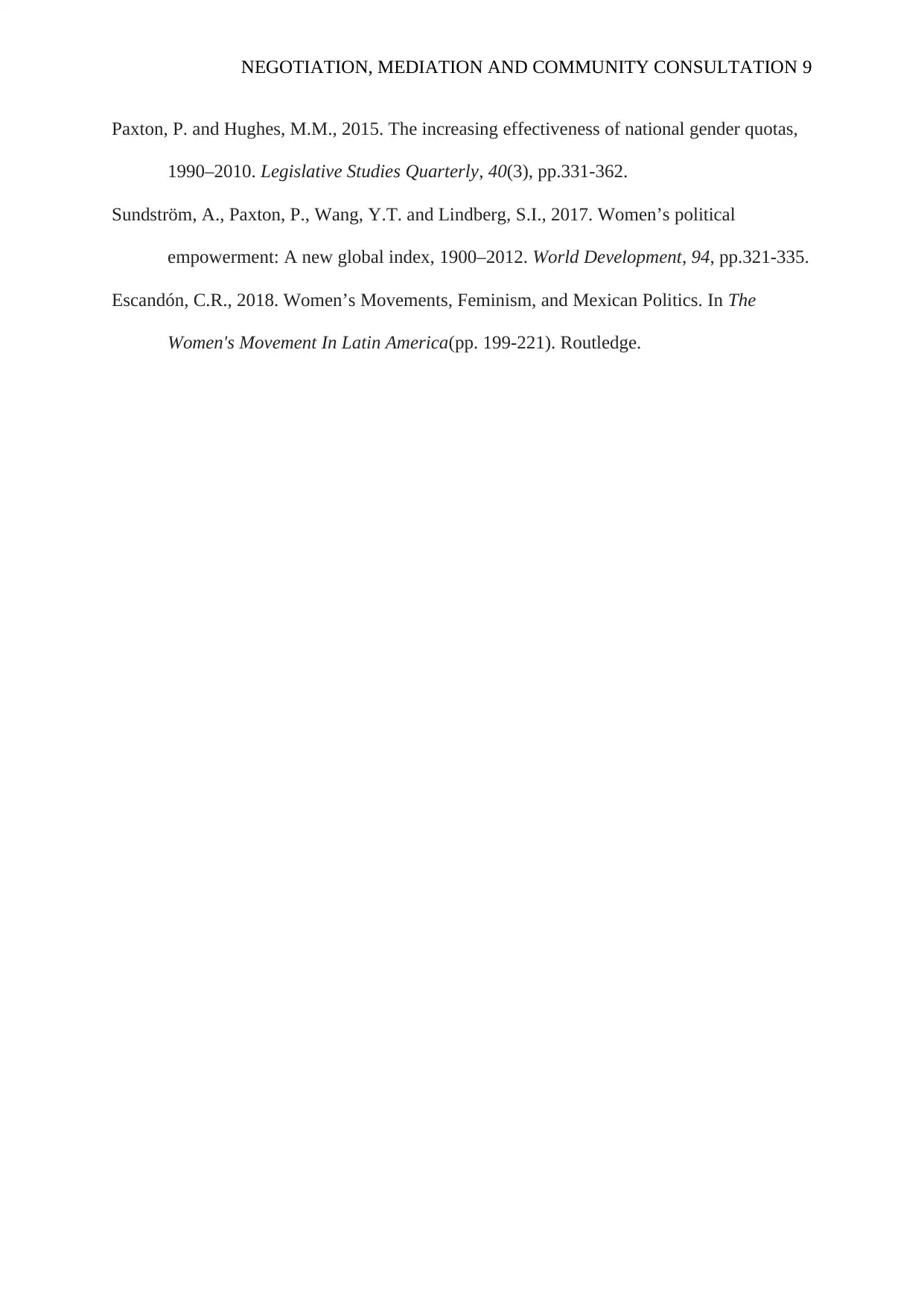
NEGOTIATION, MEDIATION AND COMMUNITY CONSULTATION 9
Paxton, P. and Hughes, M.M., 2015. The increasing effectiveness of national gender quotas,
1990–2010. Legislative Studies Quarterly, 40(3), pp.331-362.
Sundström, A., Paxton, P., Wang, Y.T. and Lindberg, S.I., 2017. Women’s political
empowerment: A new global index, 1900–2012. World Development, 94, pp.321-335.
Escandón, C.R., 2018. Women’s Movements, Feminism, and Mexican Politics. In The
Women's Movement In Latin America(pp. 199-221). Routledge.
Paxton, P. and Hughes, M.M., 2015. The increasing effectiveness of national gender quotas,
1990–2010. Legislative Studies Quarterly, 40(3), pp.331-362.
Sundström, A., Paxton, P., Wang, Y.T. and Lindberg, S.I., 2017. Women’s political
empowerment: A new global index, 1900–2012. World Development, 94, pp.321-335.
Escandón, C.R., 2018. Women’s Movements, Feminism, and Mexican Politics. In The
Women's Movement In Latin America(pp. 199-221). Routledge.
⊘ This is a preview!⊘
Do you want full access?
Subscribe today to unlock all pages.

Trusted by 1+ million students worldwide
1 out of 9
Related Documents
Your All-in-One AI-Powered Toolkit for Academic Success.
+13062052269
info@desklib.com
Available 24*7 on WhatsApp / Email
![[object Object]](/_next/static/media/star-bottom.7253800d.svg)
Unlock your academic potential
Copyright © 2020–2025 A2Z Services. All Rights Reserved. Developed and managed by ZUCOL.




